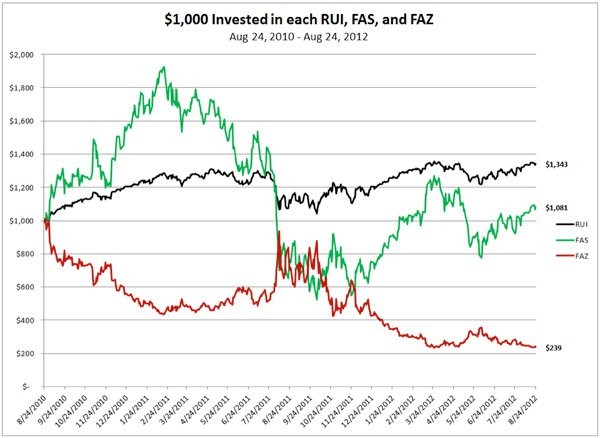Leveraged ETFs Are They Worth It
Post on: 12 Июнь, 2015 No Comment

Reuters
Exchange-traded funds have become extremely popular investment vehicles. They offer the diversification of mutual funds at a fraction of the cost, leaving more money in investors’ pockets. But buyer beware, some of them expose investors to hidden risk.
ETFs generally
ETFs come in all shapes and sizes. The largest is the well-known SPDR SP 500, which tracks its namesake index and recently topped the $100 billion mark in assets under management. Closely behind it in size is the SPDR Gold Trust (NYSE: GLD  ). which invests in gold bullion. It has $68 billion in assets under management and was attributed with changing the world in seven years by The Motley Fool’s own Chris Barker.
On the other end of the spectrum are newer and smaller funds. By one estimate, the smallest 1,000 ETFs account for less than 2% of industry trading volume.
In addition to your vanilla ETFs that track a particular index on a one-for-one basis, there are also leveraged funds. These aim to use derivatives to deliver two or three times the daily returns of the underlying index, and typically go by names like ultra short or double long.
The best-known of these is probably the ProShares UltraShort 20+ Year Treasury, which investors refer to simply as the TBT, after its ticker symbol. This fund seeks daily investment results that correspond to twice the inverse of the daily performance of an index of all Treasury securities with a remaining maturity greater than 20 years — a mouthful, I know.
Because of the potential for larger profits, sales of leveraged funds have soared in recent years. They now account for $45 billion in investor assets. As the market tumbled last August, investors poured $3 billion into these funds, the second-highest capital inflow of all ETF categories, according to the research firm Strategic Insight as cited by Fortune.
The hidden cost of amped-up ETFs
What many investors don’t know is that leveraged funds come with a potential cost that doesn’t accompany their nonleveraged brethren. This cost is associated with the fact that leveraged funds reset each day. Let’s go through the theoretical example provided in the aforementioned Fortune Magazine article to see how this distorts an investor’s returns.
Say you invest $100 in both a traditional fund and a leveraged fund that track an identical index. If the index rises 10% on the first day, the traditional fund will be worth $110 and the leveraged fund $120. On the second day, however, the index loses 10%. While the traditional fund drops to $99 ($110-$11), the leveraged fund drops to $96 ($120-$24). And here is where it gets interesting, because if you repeat the process multiple times, the gap widens, generating larger and larger losses even if the index ultimately ends in the same place that it started.
A 2009 article from a fellow Fool analyst provides a real-life example of how this played out in leveraged real estate ETFs at the end of 2008 — when the real estate market was crashing, mind you.
At the time, one would have thought that owning a double-short real estate ETF like the ProShares UltraShort Real Estate ETF (NYSE: SRS  ) would have worked out pretty well. Some may have even called you prescient, considering how few people foresaw the coming of the housing crisis. Indeed, given that its leveraged cousin on the long side, the ProShares Ultra Real Estate ETF (NYSE: URE  ). had fallen a whopping 85% over the preceding year, one would have been excused for thinking that the short side would have been up the corresponding amount. It turns out, however, that the short ETF had also dropped more than 40%.
To drive this point home, it was the same story with leveraged financial ETFs at the time. During the last six months of 2008, the double-levered, long-sided ProShares Ultra Financials (NYSE: UYG  ) had fallen almost 70%, while the corresponding double-levered, short-sided ProShares UltraShort Financials (NYSE: SKF  ) also dropped nearly 35%. And this was a mere three months after Lehman Brothers collapsed!
How could this be? The answer, of course, is the same that I gave above. Because these track the daily changes in the target indices, they are bad long-term investments due to the cost of constantly resetting the fund’s positions. As Fool analyst Dan Caplinger put it: The key here is that investors picked ETFs that focused on daily returns. If they wanted leverage for a longer period, they should have picked an investment that was better suited for that purpose.
Foolish bottom line
The moral of this story is simple. While leveraged ETFs can make great short-term plays, be wary of them as long-term holds.
+ Follow Fox Business on Facebook














